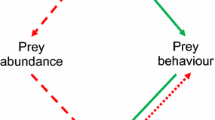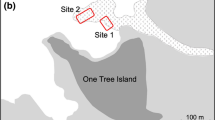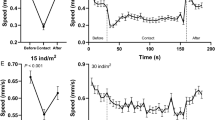Abstract
Field observations and manipulative experiments in a nearshore cobble bed (2 to 3 m below mean low water) at Eagle Head, Nova Scotia, Canada, between 1984 and 1986, showed that small juveniles ofStrongylocentrotus droebachiensis (3 to 6 mm diam) sheltering beneath cobbles had a refuge from predators such as rock crabs, small lobsters, and fish. Sea urchins gradually outgrew these refuges and small adults (25 to 30 mm) required larger rocks as shelter from predators, particularly large cancrid crabs. Small juveniles were usually solitary and well dispersed beneath cobbles, whereas small adults tended to aggregate on the undersides and in the interstices of boulders. These aggregations may develop passively as sea urchins accumulate in suitablysized refuges. Chemotaxis experiments indicate that juvenileS. droebachiensis are repelled by waterborne stimuli from conspecifics. In a factorial experiment, effects of the presence of potential predators (rock crabs and lobsters) and/or food (kelp) on the behaviour of large juvenile (10 to 15 mm) and small adult sea urchins were examined in flowing seawater tanks. Both size classes formed exposed feeding aggregations when kelp was provided as food, irrespective of the presence or absence of predators. In the absence of kelp, each size class responded differently to the presence of a predator: juveniles became more cryptic, whereas adults aggregated on the tank sides. Increased movement to the sides of a tank in the presence of a predator may reflect a flight response, since chemotaxis experiments indicated thatS. droebachiensis is repelled by waterborne chemical stimuli from predators. Observational and experimental data suggest that predation at the late juvenile and early adult stages may influence population structure, distribution and abundance ofS. droebachiensis.
Similar content being viewed by others
Literature cited
Andrew, N. L., Choat, J. H. (1982). The influence of predation and conspecific adults on the abundance of juvenileEvechinus chloroticus (Echinoidea: Echinometridae). Oecologia (Berl.) 54: 80–87
Andrew, N. L., Choat, J. H. (1985). Habitat related differences in the survivorship and growth of juvenile sea urchins. Mar. Ecol. Prog. Ser. 27: 155–161
Bernstein, B. B., Schroeter, S. C., Mann, K. H. (1983). Sea urchin (Strongylocentrotus droebachiensis) aggregating behavior investigated by a subtidal multifactorial experiment. Can. J. Fish. aquat. Sciences 40: 1975–1986
Bernstein, B. B., Williams, B. E., Mann, K. H. (1981). The role of behavioral responses to predators in modifying urchins' (Strongylocentrotus droebachiensis) destructive grazing and seasonal foraging patterns. Mar. Biol. 63: 39–49
Breen, P. A., Carolsfeld, W., Yamanaka, K. L. (1985). Social behaviour of juvenile red sea urchins,Strongylocentrotus franciscanus (Agassiz). J. exp. mar. Biol. Ecol. 92: 45–61
Breen, P. A., Mann, K. H. (1976). Destructive grazing of kelp by sea urchins in eastern Canada. J. Fish. Res. Bd Can. 33: 1278–1283
Cowen, R. K. (1983). The effect of sheephead (Semicossyphus pulcher) predation on red sea urchin (Strongylocentrotus franciscanus) populations: an experimental analysis. Oecologia (Berl.) 58: 249–255
Ebeling, A. W., Laur, D. R., Rowley, R. J. (1985). Severe storm disturbances and reversal of community structure in a southern California kelp forest. Mar. Biol. 84: 287–294
Elner, R. W. (1980). Predation on the sea urchin (Strongylocentrotus droebachiensis) by the American lobster (Homarus americanus) and the rock crab (Cancer irroratus). Tech. Rep. Fish. aquat. Sciences Can. 954: 48–65 [Pringle, J. D., Sharpe, G. J., Caddy, J. F. (eds.) Proceedings of the workshop on the relationship between sea urchin grazing and commercial plant/animal harvesting.]
Elner, R. W. (1981). Diet of green crabCarcinus maenas (L.) from Port Hebert, southwestern Nova Scotia. J. Shellfish Res. 1: 89–94
Elner, R. W., Campbell, A. (1987). Natural diets of lobsterHomarus americanus from barren ground and macroalgal habitats off southwestern Nova Scotia, Canada. Mar. Ecol. Prog. Ser. 37: 131–140
Garnick, E. (1978). Behavioral ecology ofStrongylocentrotus droebachiensis (Müller) (Echinodermata: Echinoidea). Aggregating behavior and chemotaxis. Oecologia (Berl.) 37: 77–84
Green, J. M., Martel, G., Martin, D. W. (1984). Comparisons of the feeding activity and diets of male and female cunnersTautogolabrus adspersus (Pisces: Labridae). Mar. Biol. 84: 7–11
Harrold, C., Pearse, J. S. (1987). The ecological role of echinoderms in kelp forests. In: Jangoux, M., Lawrence, J. M. (ed.) Echinoderm studies. Vol. 2. A. A. Balkema, Rotterdam, p. 137–233
Harrold, C., Reed, R. C. (1985). Food availability, sea urchins grazing, and kelp forest community structure. Ecology 66: 1160–1169
Hart, M. W., Scheibling, R. E. (1988). Heat waves, baby booms, and the destruction of kelp beds by sea urchins. Mar. Biol. 99: 167–176
Highsmith, R. C. (1982). Induced settlement and metamorphosis of sand dollar (Dendraster exentricus) larvae in predator-free sites: adult sand dollar beds. Ecology 63: 329–337
Himmelman, J. H. (1986). Population biology of green sea urchins on rocky barrens. Mar. Ecol. Prog. Ser. 33: 295–306
Himmelman, J. H., Cardinal, A., Bourget, E. (1983). Community development following removal of urchins,Strongylocentrotus droebachiensis, from the rocky subtidal zone of the St. Lawrence Estuary, Eastern Canada. Oecologia (Berl.) 59: 27–39
Himmelman, J. H., Steele, D. H. (1971). Foods and predators of the green sea urchinStrongylocentrotus droebachiensis in Newfoundland waters. Biol. 9: 315–322
Johnson, C. R., Mann, K. H. (1986). The importance of plant defence abilities to the structure of subtidal seaweed communities: the kelpLaminaria longicruris de la Pylaie survives grazing by the snailLacuna vincta (Montagu) at high population densities. J. exp. mar. Biol. Ecol. 97: 231–267
Keats, D. W. (1990). Food of winter flounderPseudopleuronectes americanus in a sea urchin dominated community in eastern Newfoundland. Mar. Ecol. Prog. Ser. 60: 13–22
Keats, D. W., South, G. R., Steele, D. H. (1985). Ecology of juvenile green sea urchins (Strongylocentrotus droebachiensis) at an urchin dominated sublittoral site in eastern Newfoundland. In: Keegan, B. F., O'Conner, B. D. S. (eds.) Echinodermata. A. A. Balkema, Rotterdam, p. 295–302
Keats, D. W., Steele, D. H., South, G. R. (1986). Atlantic wolffish (Anarhichas lupus L.; Pisces: Anarhichidae) predation on green sea urchins (Strongylocentrotus droebachiensis (O. F. Müll.); Echinodermata: Echinoidea) in eastern Newfoundland. Can. J. Zool. 64: 1920–1925
Keats, D. W., Steele, D. H., South, G. R. (1987). Ocean pout (Macrozoarces americanus (Bloch and Schneider) (Pisces: Zoarcidae)) predation on green sea urchins (Strongylocentrotus droebachiensis (O. F. Müll.) (Echinodermata: Echinoidea)) in eastern Newfoundland. Can. J. Zool. 65: 1515–1521
Lawrence, J. M. (1975). On the relationships between marine plants and sea urchins. Oceanogr. mar. Biol. A. Rev. 13: 213–286
Mann, K. H. (1977). Destruction of kelp-beds by sea urchins: a cyclical phenomenon or irreversible degradation? Helgoländer wiss. Meeresunters. 30: 455–467
Mann, K. H. (1982). Kelp, sea urchins and predators: a review of strong interactions in rocky ecosystems of eastern Canada, 1970–1980. Neth. J. Sea Res. 16: 414–423
Mann, K. H. (1985). Invertebrate behaviour and the structure of marine benthic communities. In: Sibley, R. M., Smith, R. H. (eds.) Behavioural ecology. Blackwell Scientific Publications, Oxford, p. 227–246
Mann, K. H., Wright, J. L. C., Welsford, B. E., Hatfield, E. (1984). Responses of the sea urchinStrongylocentrotus droebachiensis (O. F. Müller) to water-borne stimuli from potential predators and potential food algae. J. exp. mar. Biol. Ecol. 79: 233–244
Martel, A., Larrivée, D. H., Klein, K. R., Himmelman, J. H. (1986). Reproductive cycle and seasonal feeding activity of the neogastropodBuccinum undatum. Mar. Biol. 92: 211–221
Miller, R. J. (1985a). Succession in sea urchin and seaweed abundance in Nova Scotia, Canada. Mar. Biol. 84: 275–286
Miller, R. J. (1985b). Seaweeds, sea urchins, and lobsters: a reappraisal. Can. J. Fish. aquat. Sciences 42: 2061–2072
Pratt, D. M. (1974). Attraction to prey and stimulus to attack in the predatory gastropodUrosalpinx cinerea. Mar. Biol. 27: 37–45
Pringle, J. D., Sharp, G. J., Caddy, J. F. (1982). Interactions in kelp bed ecosystems in the northwest Atlantic: review of a workshop. In: Mercer, M. C. (ed.) Multispecies approaches to fisheries management advice. Spec. Publs Can. Fish. aquat. Sciences 59: 108–115
Raymond, B. G. (1985). Behavior and growth of the early life history stages ofStrongylocentrotus droebachiensis. M.Sc. thesis. Dalhousie University, Halifax, Nova Scotia, Canada
Raymond, B. G., Scheibling, R. E. (1987). Recruitment and growth of the sea urchinStrongylocentrotus droebachiensis (Müller) following mass mortalities off Nova Scotia, Canada. J. exp. mar. Biol. Ecol. 108: 31–54
Rowley, R. J. (1990). Newly settled sea urchins in a kelp bed and urchin barren ground: a comparison of growth and mortality. Mar. Ecol. Prog. Ser. 62: 229–240
Rumrill, S. S., Pennington, J. T., Chia, F.-S. (1985). Differential susceptibility of marine invertebrate larvae: laboratory predation of sand dollar,Dendraster excentricus (Eschscholtz), embryos and larvae by zoea and the red crab,Cancer productus Randall. J. exp. mar. Biol. Ecol. 90: 193–208
Scheibling, R. E. (1984a). Predation by rock crabs (Cancer irroratus) on diseased sea urchins (Strongylocentrotus droebachiensis) in Nova Scotia. Can. J. Fish. aquat. Sciences 41: 1847–1851
Scheibling, R. E. (1984b). Echinoids, epizootics and ecological stability in the rocky subtidal off Nova Scotia, Canada. Helgoländer Meeresunters. 37: 233–242
Scheibling, R. E. (1986). Increased macroalgal abundance following mass mortalities of sea urchins (Strongylocentrotus droebachiensis) along the Atlantic coast of Nova Scotia. Oecologia (Berl.) 68: 186–198
Scheibling, R. E., Raymond, B. G. (1990). Community dynamics on a subtidal cobble bed following mass mortalities of sea urchins. Mar. Ecol. Prog. Ser. 63: 127–145
Scheibling, R. E., Stephenson, R. L. (1984). Mass mortality ofStrongylocentrotus droebachiensis (Echinodermata: Echinoidea) off Nova Scotia, Canada. Mar. Biol. 78: 153–164
Sloan, N. A., Lauridsen, C. P., Harbo, R. M. (1987). Recruitment characteristics of the commercially harvested red sea urchinStrongylocentrotus franciscanus in southern British Columbia, Canada. Fish. Res. 5: 55–69
Tegner, M. J., Dayton, P. K. (1977). Sea urchin recruitment patterns and implications of commercial fishing. Science, N.Y. 196: 324–326
Tegner, M. J., Dayton, P. K. (1981). Population structure, recruitment and mortality of two sea urchins (Strongylocentrotus franciscanus andS. purpuratus) in a kelp forest. Mar. Ecol. Prog. Ser. 5: 255–268
Tegner, M. J., Levin, L. A. (1983). Spiny lobsters and sea urchins: analysis of a predator-prey interaction. J. exp. mar. Biol. Ecol. 73: 125–150
Vadas, R. L. Elner, R. W., Garwood, P. E., Babb, I. G. (1986). Experimental evaluation of aggregation behavior in the sea urchinStrongylocentrotus droebachiensis. A reinterpretation Mar. Biol. 90: 433–448
Wharton, W. G., Mann, K. H. (1981). Relationship between destructive grazing by the sea urchin,Strongylocentrotus droebachiensis, and the abundance of American lobster,Homarus americanus, on the Atlantic coast of Nova Scotia. Can. J. Fish. aquat. Sciences 38: 1339–1349
Witman, J. D. (1985). Refuges, biological disturbance, and rocky subtidal community structure in New England. Ecol. Monogr. 55: 421–445
Zar, J. H. (1984). Biostatistical analysis. 2nd ed. Prentice-Hall, Inc., Englewood Cliffs, N.J.
Author information
Authors and Affiliations
Additional information
Communicated by J.M. Lawrence, Tampa
Rights and permissions
About this article
Cite this article
Scheibling, R.E., Hamm, J. Interactions between sea urchins (Strongylocentrotus droebachiensis) and their predators in field and laboratory experiments. Mar. Biol. 110, 105–116 (1991). https://doi.org/10.1007/BF01313097
Accepted:
Issue Date:
DOI: https://doi.org/10.1007/BF01313097




